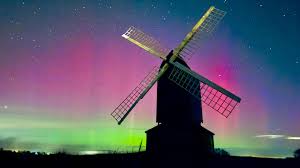Rare Steve phenomenon and Northern Lights dazzle in UK skies

London: UK sky-watchers on Monday night were treated to the rare phenomenon known as Steve.
While Steve can look like the aurora and often appears during a showing of the Northern Lights, it is fundamentally different.
Steve is a relatively new scientific discovery and last night was spotted in parts of Scotland and north-east England.
There was also some spectacular sightings of the Northern Lights as far south as Buckinghamshire and Norfolk.
Steve – or to give it its full name, Strong Thermal Emission Velocity Enhancement – is unpredictable and only lasts for a short time.
Little is known about its formation and why it can sometimes appear during an aurora display.
While auroras happen in an oval shape, Steve appears as a ribbon and lasts for 20 minutes to an hour before disappearing.
While Steve is only spotted in the presence of an aurora, it is not a normal aurora as scientists suggests it comprises a fast-moving stream of extremely hot particles called a sub-auroral ion drift, or SAID.
As Steve is unpredictable and only lasts for a short time, recording occurrences from the ground is rare.
The last sightings of Steve in the UK were back in November 2023.
While there have been photographs of Steve for decades, it only got the name Steve in 2016, following a US citizen science project funded by Nasa and the National Science Foundation.
Steve was spotted between the clouds in the Highlands on Monday night by a BBC Weather Watcher
The inspiration behind the glow’s name is thought to be a scene from the animated movie Over the Hedge.
In it, a group of animals awake from hibernation to find what to them is another awe-inspiring phenomenon – a big garden hedge.
“What is this thing?” one creature says.
“I’d be a lot less afraid of it if I just knew what it was called,” another says, before a squirrel recommends calling it Steve.
“I’m a lot less scared of Steve,” another animal replies.
Scientists later adapted the name into an acronym: Strong Thermal Emission Velocity Enhancement.
And it is not just sky-watchers who have shown an interest in Steve.
In 2019, the Canadian government minted a collector’s coin worth $20 featuring the mysterious streaks of light.
As well as Steve, the Northern Lights were spotted across the UK through Monday night and early Tuesday morning.
There were sightings from our BBC Weather Watchers from the Western Isles, Buckinghamshire and as far south as Kent.
Activity on the Sun has remained high since one of the largest solar flares in seven years last week.
Solar winds have sent charged particles towards Earth with aurora expected over the last few nights.
However, it has been too cloudy for most with the timing of aurora not quite coinciding with UK night-time.
More sightings of the Northern Lights are possible in the next few nights – cloud permitting – as solar activity remains relatively high.





